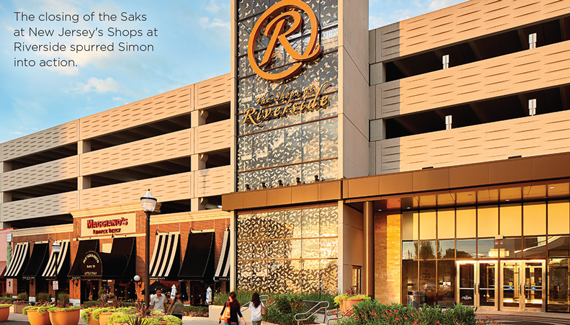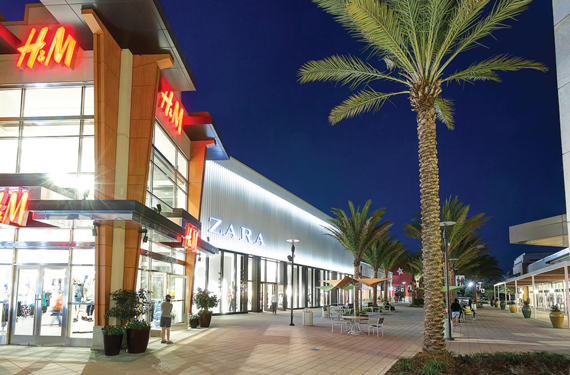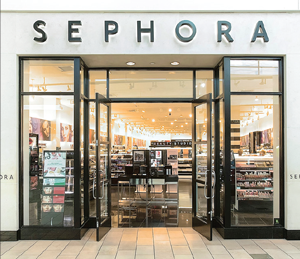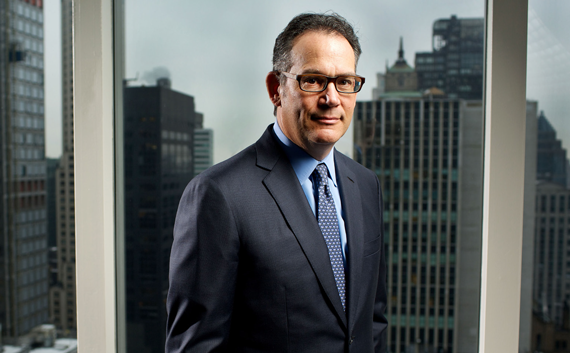When Saks Fifth Avenue, one of the great old American department stores, shuttered its location at the Shops at Riverside in Hackensack in 2014, the closure left a major hole in the fabric of the New Jersey property.
The Saks branch had been the centerpiece of the mall since its 1977 debut to great fanfare as an anchor tenant. For many years the store was a major draw for New Jersey shoppers who wished for a taste of Manhattan glamour at their doorsteps. In the years following the financial crisis, Saks’ glory days were gone; sales lagged and the store was besieged by competition from rivals such as Bloomingdale’s and Neiman Marcus.
The closing also had the potential to cause a big problem for the mall’s owner: Retail behemoth Simon Property Group — the largest mall operator in the U.S. — was suddenly faced with 100,000 square feet of vacant property.
This is an issue that Simon Property Group (SPG) and its competitors have faced over and over, as traditional anchor tenants that inked deals decades ago struggle to keep sales speeding along in a drastically altered retail landscape.
But it’s now clear that the slow, painful death of the anchor tenant has served as the kiss of life for some of the country’s largest mall owners — and SPG in particular.
After taking back the Saks space, the Indianapolis-based real estate investment trust, led by David Simon, inked a deal to bring a nine-screen AMC movie theater, a bowling alley and a bocce restaurant to the space.

The move from straight retail into experiential retail marked an attempt to reinvigorate the space and give consumers, particularly younger ones, more reasons to visit the mall than simply to shop. During a fourth-quarter earnings call, Simon called it a “great example of just taking [an] underperforming Saks that was not attracting the consumer” and repositioning it. “We went from, I think, a $10 million Saks to $50 million of revenue generated after repurposing that box.”
The hustle to attract more interactive anchor alternatives is emblematic of SPG’s larger push to adapt to a changing environment, boost its traffic and occupancy levels and better cater to the needs of younger and wealthier customers.
“The role of the anchor remains the same — to drive traffic to the shopping center,” said Gene Spiegelman, the head of U.S. retail at Cushman & Wakefield. “It’s just the nature of those anchors that’s changed. It still needs to be a compelling offering so that it drives consistent traffic to the inline retailers.”
The REIT started 2016 on a high note, posting a 15.4 percent uptick in the first quarter of the year over the same period a year earlier in funds from operations, a key measure of profitability. The company even raised its earnings forecast for 2016 after beating estimates. Occupancy rates across the portfolio also remained relatively consistent at 95.6 percent in March, compared with 95.8 percent in 2015’s first quarter.
Navigating a shifting market
For Simon Property Group, the largest real estate investment trust in the United States, repositioning anchors has become a key plank in a larger strategy to stay relevant amid the ongoing challenges of the retail industry, including a decrease in tourist spending.
Consumers have dramatically altered their buying habits in recent years, as e-commerce explodes and mall occupancy levels decline. In 2015, Simon had 1.3
mil-lion square feet of vacancies across its port-folio due to tenant bankruptcies. More than 20 anchor spaces are set to become vacant in 2016 and 2017, according to the company’s most recent figures.

Meanwhile, rents in mall properties across the country will increase by a mere 1.5 percent for existing non-anchor tenants through 2019, according to a recent estimate by Green Street Advisors.
“There was clearly a slowdown in retail sales in the back half of the year,” Simon said on the fourth-quarter call. “When you couple that with the tourism issue, you couple that with the warmer weather — I mean it was a perfect storm. It took a lot of retailers out.”
And it’s not all sunny for the REIT in terms of mall attendance either. While traffic levels at the company’s malls remained flat in 2015 (and rose minimally at some of the premium outlets), shoppers are visiting a smaller number of stores on each trip. The company has said its goal is to increase the average number of stores each shopper visits to seven or eight, which would be a spike from four or five.
“The struggle is to stay relevant, stay profitable and to maneuver through probably the most challenging shift in the retail consumer environment in the history of shopping centers,” Cushman’s Spiegelman said. “They’re spending a tremendous amount of time and effort conceptualizing, redeveloping and repositioning to keep their properties productive,” he said of SPG’s managers.
To that end, the company seems to be focusing on two segments of the market: luxury consumers and younger shoppers.
In 2014, when the company took over a vacated, underperforming Saks store at Orlando’s Florida Mall, it appealed to the tastes of baby boomers and millennials by replacing the anchor store with a large food pavilion, including options like El Meson Sandwiches, Carlo’s Bakery and Five Guys.

A food pavilion replacing the Saks at the Florida Mall aims to lure baby boomers and millennials.
A vacated Nordstrom space at the same property was sliced in two to make way for several mini anchor tenants, including the Crayola Experience, a combination retail store and visitor attraction aimed at encouraging creativity in kids.
“The millennials offer great opportunity for us,” Simon said during a third-quarter 2015 earnings call. “It’s a huge population base, greater than even the baby boomers. And we’re making the mall generally a better experience for them to be at.”

A Sephora at the Florida Mall
Wendy Seher, a senior vice president at Federal Realty Investment Trust, said Simon’s recent moves fall within a larger push inside the industry toward “experiential” retail. “It’s about creating excitement and foot traffic,” Seher said. “We’re seeing a lot of activity in restaurants and entertainment as well as in the health and wellness category, with fitness studios like Pure Barre, yoga and cycling. People want something that’s a little bit different.”
In an effort to reach affluent shoppers, SPG recently embarked on a $200 million repositioning of its Roosevelt Field mall on New York’s Long Island, expanding the footprint to make way for a new “luxury wing” geared toward high-end retail tenants such as Tory Burch and Jonathan Adler stores. A new Neiman Marcus store also opened at the mall, replete with its couture offerings. Valet parking was also added.
“Luxury shoppers used to be afraid to go to that mall,” said retail broker Faith Hope Consolo of Douglas Elliman. “Not anymore.”
Simon Property has made progress in trying to fill space vacated by its struggling anchor tenants and re-leased about 60 percent to 70 percent of the space vacated last year — for 18 percent higher rates.
“We are not going to put our space on sale,” said Rick Sokolov, SPG’s president and chief operating officer, during the fourth-quarter call. “We are holding margins.”
That means new leases could beef up the balance sheet, since anchor tenants have traditionally paid very little for their spaces.
“Basically, what it costs you to get a coffee and a bagel in the morning is what these department stores pay on a price-per-square-foot basis,” said Alexander Goldfarb, the senior REIT analyst in the research department of Sandler O’Neill + Partners.
New repositionings may also be on the horizon, since SPG recently announced a new partnership with Sears, which supplies mega-anchor stores to malls. As part of the $228 million deal, the retailer contributed 10 U.S. properties for a joint venture with Simon, which will lease them back to Sears. Rumors have been circulating about a similar deal with Macy’s, though Simon executives said during the fourth-quarter earnings call that no deal has been hammered out so far.
Continuing a Family Legacy
The company’s roots can be traced back to the swinging ’60s, when Simon’s father, retail magnate Mel Simon, teamed up with his brothers, Herb and Fred, to start Melvin Simon & Associates, a firm developing regional malls. The brothers became known as the “Marx Brothers of Malls.”
A New Yorker who, according to news accounts, grew up in a Bronx walk-up, Mel Simon began by building strip malls in Indianapolis and later expanded his business across the Midwest. One of the jewels in his crown was the Mall of America in Minnesota, which became the nation’s largest mall with 400 stores. Today his company, which went public as Simon Property Group in 1993, owns more than 200 malls around the world, in the Americas, Europe and Asia.

Mel Simon, center, with Herb Simon and Reggie Miller
“The brand is legendary,” Spiegelman said. Simon Property is “not just an operator of shopping centers. This is one of the firms that built an industry. It’s an animal.”
Famous for his tomato-red suits, Mel Simon spearheaded some of the very trends that his son is now seeking to reverse. He lured in big anchor tenants with cheap rates before the construction of a new mall even began so that banks would pony up loans for development. His suburban shopping hubs occasionally drew criticism for taking business away from city centers. Today that trend has largely been reversed.
Mel Simon’s son David has a reputation for being a tough negotiator. He sealed one deal in the 1990s by staying up to negotiate through the night after the chief of a competing firm had gone to bed, content that he’d won the deal, according to the Indianapolis Business Journal.
“He’s the big gorilla on the street,” said Consolo, who has worked with David Simon on the boards of several committees of the International Council of Shopping Centers. “He’s feared by the industry because he wields so much power.” The company “has its tentacles all over this market,” and its managers “change gears quicker than anyone else. They’re not the only ones doing it; it’s just that they do it better,” she said.
Moving beyond anchors
Simon Property Group has been striving to stay ahead of its competitors in other ways. The company has been shifting its attention to its bigger Class A malls and outlets, where traffic is stronger and occupancy levels higher. In a bid to boost its occupancy and sales-per-square-foot rates, last year SPG spun off its smaller enclosed malls into an inde-pendent, publicly traded REIT, Washington Prime Group. Some of those properties could be repositioned for alternative uses as anchor tenants fall away.
“Not every shopping center is going to find a new use for anchor space,” Spiegelman said. “Once you cross that threshold where you can’t re-anchor because it’s just endemic that the property has been outpositioned and doesn’t have a purpose in the market, then the use of the property will change.”
To stay current with innovations in the industry, SPG has invested more than $25 million in online retail startup Union Station, a dress-rental service for weddings. That business could one day take a spot at a Simon mall. The firm is also keeping up with the branded-content game, having launched the digital lifestyle platform Simon SAID, which features blog posts by fashion writers as well as some of its retail partners. “They can smell a trend a year or two before everyone else,” Consolo said about Simon Property managers. “Usually their instincts are on the mark.”
